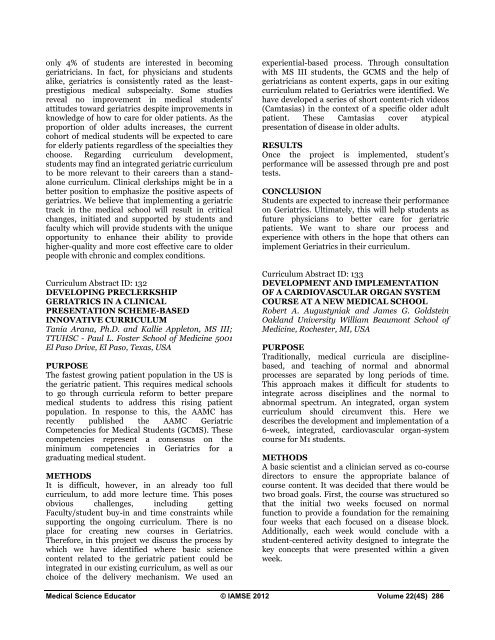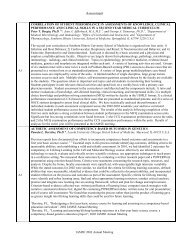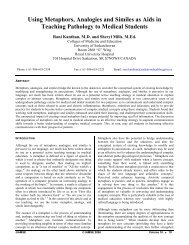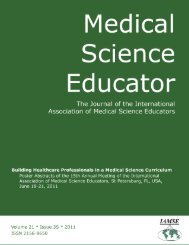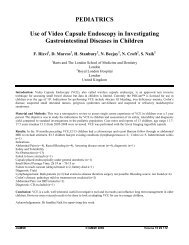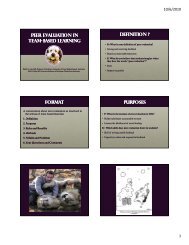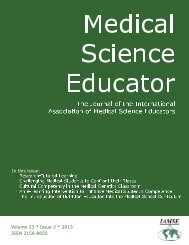Click here to view complete journal in pdf-format - IAMSE
Click here to view complete journal in pdf-format - IAMSE
Click here to view complete journal in pdf-format - IAMSE
Create successful ePaper yourself
Turn your PDF publications into a flip-book with our unique Google optimized e-Paper software.
only 4% of students are <strong>in</strong>terested <strong>in</strong> becom<strong>in</strong>g<br />
geriatricians. In fact, for physicians and students<br />
alike, geriatrics is consistently rated as the leastprestigious<br />
medical subspecialty. Some studies<br />
reveal no improvement <strong>in</strong> medical students'<br />
attitudes <strong>to</strong>ward geriatrics despite improvements <strong>in</strong><br />
knowledge of how <strong>to</strong> care for older patients. As the<br />
proportion of older adults <strong>in</strong>creases, the current<br />
cohort of medical students will be expected <strong>to</strong> care<br />
for elderly patients regardless of the specialties they<br />
choose. Regard<strong>in</strong>g curriculum development,<br />
students may f<strong>in</strong>d an <strong>in</strong>tegrated geriatric curriculum<br />
<strong>to</strong> be more relevant <strong>to</strong> their careers than a standalone<br />
curriculum. Cl<strong>in</strong>ical clerkships might be <strong>in</strong> a<br />
better position <strong>to</strong> emphasize the positive aspects of<br />
geriatrics. We believe that implement<strong>in</strong>g a geriatric<br />
track <strong>in</strong> the medical school will result <strong>in</strong> critical<br />
changes, <strong>in</strong>itiated and supported by students and<br />
faculty which will provide students with the unique<br />
opportunity <strong>to</strong> enhance their ability <strong>to</strong> provide<br />
higher-quality and more cost effective care <strong>to</strong> older<br />
people with chronic and complex conditions.<br />
Curriculum Abstract ID: 132<br />
DEVELOPING PRECLERKSHIP<br />
GERIATRICS IN A CLINICAL<br />
PRESENTATION SCHEME-BASED<br />
INNOVATIVE CURRICULUM<br />
Tania Arana, Ph.D. and Kallie Apple<strong>to</strong>n, MS III;<br />
TTUHSC - Paul L. Foster School of Medic<strong>in</strong>e 5001<br />
El Paso Drive, El Paso, Texas, USA<br />
PURPOSE<br />
The fastest grow<strong>in</strong>g patient population <strong>in</strong> the US is<br />
the geriatric patient. This requires medical schools<br />
<strong>to</strong> go through curricula reform <strong>to</strong> better prepare<br />
medical students <strong>to</strong> address this ris<strong>in</strong>g patient<br />
population. In response <strong>to</strong> this, the AAMC has<br />
recently published the AAMC Geriatric<br />
Competencies for Medical Students (GCMS). These<br />
competencies represent a consensus on the<br />
m<strong>in</strong>imum competencies <strong>in</strong> Geriatrics for a<br />
graduat<strong>in</strong>g medical student.<br />
METHODS<br />
It is difficult, however, <strong>in</strong> an already <strong>to</strong>o full<br />
curriculum, <strong>to</strong> add more lecture time. This poses<br />
obvious challenges, <strong>in</strong>clud<strong>in</strong>g gett<strong>in</strong>g<br />
Faculty/student buy-<strong>in</strong> and time constra<strong>in</strong>ts while<br />
support<strong>in</strong>g the ongo<strong>in</strong>g curriculum. T<strong>here</strong> is no<br />
place for creat<strong>in</strong>g new courses <strong>in</strong> Geriatrics.<br />
T<strong>here</strong>fore, <strong>in</strong> this project we discuss the process by<br />
which we have identified w<strong>here</strong> basic science<br />
content related <strong>to</strong> the geriatric patient could be<br />
<strong>in</strong>tegrated <strong>in</strong> our exist<strong>in</strong>g curriculum, as well as our<br />
choice of the delivery mechanism. We used an<br />
experiential-based process. Through consultation<br />
with MS III students, the GCMS and the help of<br />
geriatricians as content experts, gaps <strong>in</strong> our exit<strong>in</strong>g<br />
curriculum related <strong>to</strong> Geriatrics were identified. We<br />
have developed a series of short content-rich videos<br />
(Camtasias) <strong>in</strong> the context of a specific older adult<br />
patient. These Camtasias cover atypical<br />
presentation of disease <strong>in</strong> older adults.<br />
RESULTS<br />
Once the project is implemented, student’s<br />
performance will be assessed through pre and post<br />
tests.<br />
CONCLUSION<br />
Students are expected <strong>to</strong> <strong>in</strong>crease their performance<br />
on Geriatrics. Ultimately, this will help students as<br />
future physicians <strong>to</strong> better care for geriatric<br />
patients. We want <strong>to</strong> share our process and<br />
experience with others <strong>in</strong> the hope that others can<br />
implement Geriatrics <strong>in</strong> their curriculum.<br />
Curriculum Abstract ID: 133<br />
DEVELOPMENT AND IMPLEMENTATION<br />
OF A CARDIOVASCULAR ORGAN SYSTEM<br />
COURSE AT A NEW MEDICAL SCHOOL<br />
Robert A. Augustyniak and James G. Goldste<strong>in</strong><br />
Oakland University William Beaumont School of<br />
Medic<strong>in</strong>e, Rochester, MI, USA<br />
PURPOSE<br />
Traditionally, medical curricula are discipl<strong>in</strong>ebased,<br />
and teach<strong>in</strong>g of normal and abnormal<br />
processes are separated by long periods of time.<br />
This approach makes it difficult for students <strong>to</strong><br />
<strong>in</strong>tegrate across discipl<strong>in</strong>es and the normal <strong>to</strong><br />
abnormal spectrum. An <strong>in</strong>tegrated, organ system<br />
curriculum should circumvent this. Here we<br />
describes the development and implementation of a<br />
6-week, <strong>in</strong>tegrated, cardiovascular organ-system<br />
course for M1 students.<br />
METHODS<br />
A basic scientist and a cl<strong>in</strong>ician served as co-course<br />
direc<strong>to</strong>rs <strong>to</strong> ensure the appropriate balance of<br />
course content. It was decided that t<strong>here</strong> would be<br />
two broad goals. First, the course was structured so<br />
that the <strong>in</strong>itial two weeks focused on normal<br />
function <strong>to</strong> provide a foundation for the rema<strong>in</strong><strong>in</strong>g<br />
four weeks that each focused on a disease block.<br />
Additionally, each week would conclude with a<br />
student-centered activity designed <strong>to</strong> <strong>in</strong>tegrate the<br />
key concepts that were presented with<strong>in</strong> a given<br />
week.<br />
Medical Science Educa<strong>to</strong>r © <strong>IAMSE</strong> 2012 Volume 22(4S) 286


